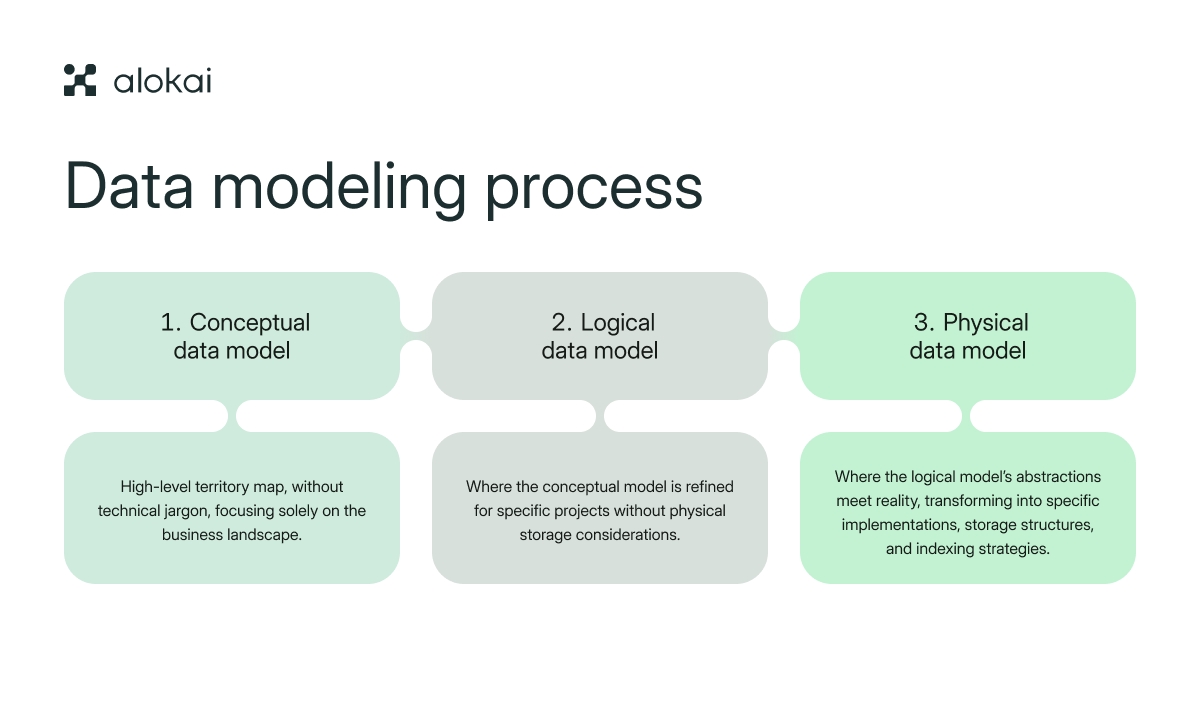A data model is a structured framework that defines how data is stored, organized, and accessed in a database. It serves as a blueprint, detailing the relationships between different data points and ensuring consistency and accuracy. Understanding data models is crucial for anyone looking to manage data effectively, optimize database performance, and leverage data for informed decision-making.
Key takeaways
- Data modeling is a three-layer process (conceptual, logical, and physical) that organizes and defines data types, relationships, and storage, bridging the gap between business concepts and technical implementations.
- Effective data modeling enhances data integrity, optimizes storage, and supports analytics-driven decision-making, making it vital for modern business operations, especially in e-commerce, healthcare, and financial services.
- Emerging trends like cloud-based data modeling, AI and machine learning integration, and real-time data processing are shaping the future of data management and offering businesses scalable, efficient, and adaptive solutions.
Understanding the basics of data modeling
At the heart of every data-driven decision is a process as essential to information systems as blueprints are to building construction. Data modeling is that process—the careful analysis and definition of data types, their relationships, and their organization. This story unfolds across three important layers: conceptual, logical, and physical data modeling. Each layer has a unique role, from outlining the big picture of business concepts to the detailed specifics of physical storage. Among these layers, logical data models play a key role in connecting the broad concepts with the detailed implementations.
We will now examine these layers, comprehend their roles, and observe their fusion to establish cohesive data models.

Conceptual data model
The conceptual data model is where our journey begins. It’s a high-level territory map, devoid of technical jargon, focusing solely on the business landscape. Envision a blueprint that captures the essence of business entities, their attributes, and the relationships between them. Conceptual data modeling is a visual narrative that tells a story of the business without getting bogged down by the complexities of how the data will be stored or processed.
This model primarily focuses on comprehending the wide-ranging business concepts and the data they produce.
Logical data model
Moving deeper into the data modeling process, we arrive at the logical data model. This is where the conceptual model is refined for specific projects, devoid of physical storage considerations. It structures the data elements and relationships from the conceptual blueprint into a more detailed and project-specific framework. It’s a critical step where business requirements begin to take on a more defined shape, ensuring that data structures are detailed enough for technical teams yet still understandable for business stakeholders.
Physical data model
The final descent in the data modeling process brings us to the physical data model. This is where the logical model’s abstractions meet reality, transforming into specific implementations, storage structures, and indexing strategies. It encompasses the actual database structure, considering the performance requirements of the database management system.
The physical model concentrates on physical data modeling, maximizing data for storage and retrieval, and guaranteeing efficient database performance under the pressures of real-world applications. One of the key aspects of this process is the creation of physical data models, which serve as a blueprint for the database structure.
The importance of data modeling in modern business
In the high-stakes theatre of modern business, data modeling stands as a linchpin, underpinning the integrity of data, optimizing storage, and empowering analytics-driven decisions. It’s a strategic process that bridges the gap between raw data and actionable insights, aligning business and technology goals. By creating a structured representation of data, companies can manage their data more effectively, reduce development errors, and ensure that data governance is systematically managed.
We will now investigate the distinct advantages that data modeling offers to a business.
Enhancing data integrity
Data integrity is the cornerstone of trust in any data system. Through data modeling, businesses enforce relationships and constraints that maintain the consistency and accuracy of data. By defining clear rules for how data is entered and related, data models act as gatekeepers, preventing the chaos of inconsistency and ensuring that every piece of data fits into the larger puzzle perfectly.
Not only does this enhance workflows but also protects compliance, rendering data models indispensable in industries where accuracy is of utmost importance.
Optimizing data storage
As the digital universe expands, so does the need for efficient data storage solutions. Data modeling answers this call by minimizing redundancy, structuring data logically, and striking a delicate balance between normalization and denormalization.
By organizing data into well-thought-out schemas, businesses can optimize their storage requirements, manage their data better, and ensure swift data retrieval, especially in high-traffic scenarios like e-commerce, using database management systems.
Supporting decision-making with analytics
In a world where the next business breakthrough hinges on the latest data insight, well-structured data models are the launchpads for informed decision-making. By facilitating efficient data analysis and reporting, these models provide the clarity needed for business analysts to derive insights swiftly and support strategic business decisions.
Across various industries, data models are the engines that drive the analytics machine, simplifying complex data structures for better understanding and use.
Key data modeling techniques
Beyond the theoretical framework of data models lies the practical matrix of techniques that ensure data quality and operational efficiency. It’s the craftsman’s toolkit for the data modeler, comprising methods like Entity-Relationship Diagrams, Dimensional Modeling, and Normalization. These techniques form the backbone of resilient data architecture, each with a unique role in maintaining the integrity and utility of data.
We will now analyze these techniques to learn their contribution towards the robustness of data models.
Entity-relationship diagrams (ERD)
Entity-relationship diagrams are the visual storytellers of the data modeling world. They illustrate entities and their interconnections with a clarity that transcends language barriers. These diagrams define entities, their attributes, and the intricate web of relationships that bind them, laying out a visual representation of complex data structures within a relational database.
It’s a technique that brings the abstract into the realm of the concrete, allowing stakeholders to see and understand the data landscape.
Dimensional modeling
When the narrative of data turns to analysis and intelligence, dimensional modeling takes the stage. It’s a technique that organizes data into dimensions and facts, structuring it so that it becomes a breeze to navigate vast warehouses of information.
In the realm of business intelligence applications, dimensional modeling shines, enabling fast query performance and providing easy access to crucial data for analysis.
Normalization
The art of normalization is all about achieving data serenity. It involves:
- Minimizing redundancy
- Ensuring data integrity is not just a goal but a reality
- Organizing data into tables
- Defining relationships
- Reducing the noise of unnecessary duplication
- Making sure that changes in one area of the data model ripple through the system with precision.
It’s a balancing act that, when performed correctly, translates into a database that hums with efficiency.
Choosing the right data modeling tools
As the adage goes, “A craftsman is only as good as his tools,” and in the world of data modeling, the choice of tools can make or break a project. Selecting the right data modeling tool is a strategic decision that weighs factors like:
- User experience
- Performance
- Scalability
- Maintenance
- Security
It’s about finding a tool that not only fits the technical specifications but also aligns with the business’s long-term goals and workflows.
We will now identify the features to consider in a data modeling tool to guarantee its appropriateness.
Evaluating user experience
A data modeling tool should:
- Offer an intuitive user experience, accessible to both technical experts and business professionals
- Have user-friendly interfaces and visual representations
- Simplify the complex processes of data modeling
- Make it easier for teams to communicate data structures
- Facilitate effective collaboration
Considering performance and scalability
Performance and scalability are the twin pillars that support the growing edifice of data. A tool that crumbles under the weight of expanding data volumes is no good. Data modeling tools must be robust, handling data structures and traffic with ease, ensuring that as the business scales, the data architecture can rise to meet the challenge without faltering.
Ensuring security and compliance
In the digital age, data is both a treasure trove and a target. Ensuring the security and compliance of data is non-negotiable, and the tools employed for data modeling must prioritize these aspects.
With the right tool, sensitive customer information and business data are fortified against threats, and compliance with regulatory standards is seamlessly maintained.
Practical applications of data models
Data models are not just theoretical constructs; they are the engines that drive real-world business operations across diverse industries. From e-commerce to healthcare to financial services, data models streamline processes, ensure data integrity, and pave the way for innovative solutions.
We will now investigate the practical applications of data models and observe their ability to organize chaotic data into actionable insights and efficient operations.
Ecommerce platforms
Within the dynamic realm of e-commerce, data models are the scaffolding that supports every digital transaction and customer interaction. From managing vast product catalogs to tracking customer behavior and processing orders, a well-crafted data model empowers platforms to operate efficiently and glean insights that drive growth and customer satisfaction. It’s the backbone that enables e-commerce businesses to adapt, thrive, and excel in an ever-evolving market.
Healthcare systems
Healthcare systems have a critical need for robust data models to manage and safeguard patient information. Electronic health records (EHRs) are a testament to the power of data modeling in organizing patient demographics, diagnoses, and treatment plans, ensuring that healthcare providers have access to comprehensive, up-to-date patient information.
Through effective data modeling, healthcare systems can enhance patient care and optimize their operations.
Financial services
Financial institutions are built on the foundation of trust and precision, both of which are reinforced by sophisticated data models. These models facilitate efficient transaction processing, bolster risk management efforts, and enhance fraud detection capabilities.
By leveraging data models, financial services can navigate the complex waters of the financial world with confidence, ensuring that data informs every decision and safeguards the institution’s integrity.
Future trends in data modeling
As the tapestry of technology continues to evolve, so too does the field of data modeling. Cloud-based solutions, AI and machine learning integrations, and real-time data processing are shaping the future of data structures and management.
By keeping up with these trends, businesses can leverage the latest advancements and ensure their data architecture is robust and prepared for future demands.
Cloud-based data modeling
The cloud is revolutionizing the way we think about data storage and processing, offering scalable, flexible solutions that grow with the business. Cloud-based data modeling platforms provide the agility to manage vast amounts of data without the constraints of traditional on-premise infrastructure, enabling businesses to adapt to data growth and technological changes with ease.
Integration with AI and machine learning
Artificial intelligence and machine learning are transforming the data modeling landscape by automating routine tasks, providing deep insights, and dynamically adjusting data models for optimal performance. These technologies promise to revolutionize the way we analyze and manage data, driving efficiency and innovation across every industry that relies on data-driven decision-making.
Real-time data processing
The need for speed in data processing has never been greater. Real-time data models are essential for applications that require immediate insights, such as fraud detection, dynamic pricing, and instant recommendations.
By enabling real-time data processing, businesses can respond to events as they happen, providing a competitive edge in a fast-paced world.
Summary
As we reach the end of our expedition through the world of data modeling, it’s clear that the meticulous crafting of data structures is not just a technical endeavor but a strategic business imperative. From conceptual sketches to the final strokes of the physical model, data modeling shapes the very foundation upon which businesses operate and innovate. Embrace these principles, techniques, and tools, and you’ll be well-equipped to navigate the data-driven landscape of the future, turning information into insight and insight into action.













